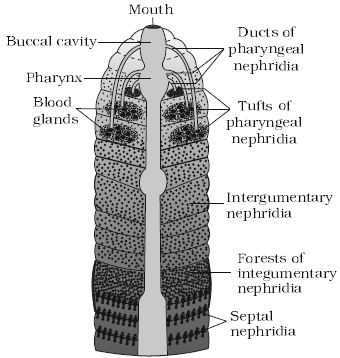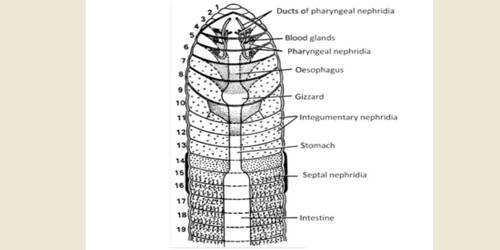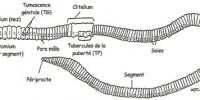Earthworms have a pair of excretory organs called nephridia in almost all segments. The excretory organs occur as segmentally arranged coiled tubules called nephridia (sing.: nephridium). They excrete the waste through a pair of pores in each segment. The excretory organs of insects are called Malpighian tubules.
They are of three types:
(i) septal nephridia, present on both the sides of intersegmental septa of segment 15 to the last that open into the intestine. They are well developed and the largest nephridia and found attached to both sides of each intersegmental septum behind the 15th segment. Each septum has 40-50 septal nephridia and they are arranged in two rows. So each septum has 80-100 septal nephridia. Septal excretory duct collects the excretory products and transfers them to a pair of the supra-intestinal excretory duct. Septal nephridia discharge the waste products through the canal and ducts into the lumen of the intestine.
- It is funnel-shaped and externally ciliated, opening into the coelomic cavity.
- It consists of mouth like opening, which is surrounded by a larger upper lip and smaller lower lip.
(ii) integumentary nephridia, attached to the lining of the body wall of segment 3 to the last that opens on the body surface. They are attached to the inner side of the body wall from the 7th to the last segment. The number of integumentary nephridia ranges from 200-250 in each segment but in the clitellar region, their number is about 2000-2500. So clitellum is called the forest of nephridia. They discharge nitrogenous metabolic waste products directly outside of the body through nephridiopores. So they are called exonephric nephridia.
(iii) pharyngeal nephridia, present as three paired tufts in the 4th, 5th and 6′ segments (Figure). They are found as paired and lie one pair in each of the 4th, 5th, and 6th segments. They discharge the waste products directly into the buccal cavity and pharynx from where these are passed outside with undigested food through the anus.

A nephridium starts out like a funnel that collects excess fluid from the coelomic chamber. These different types of nephridia are basically similar in structure. Nephridia regulate the volume and composition of body fluids. Flame cells are excretory cells in the simplest freshwater invertebrates. Malpighian tubules are a type of excretory system in some arachnids. A nephridium starts out like a funnel that collects excess fluid from the coelomic chamber. All the terminal ducts of a segment open into the septal excretory duct of their side. Septal excretory duct collects the excretory products and transfers them to a pair of the supra-intestinal excretory duct. The funnel connects with a tubular part of the nephridium which delivers the wastes through a pore to the surface in the body wall into the digestive tube.














